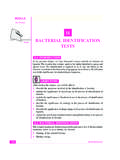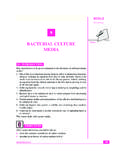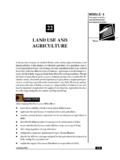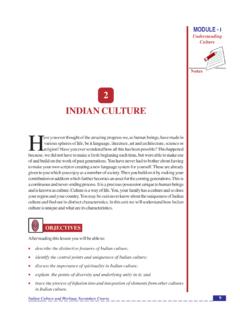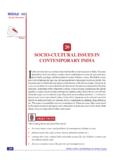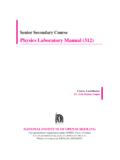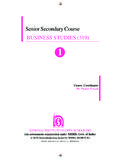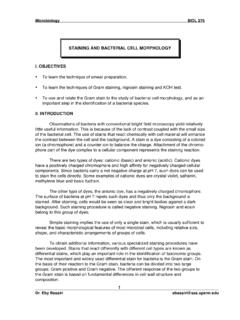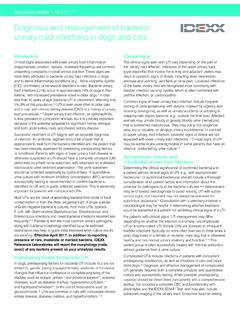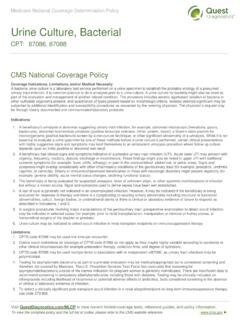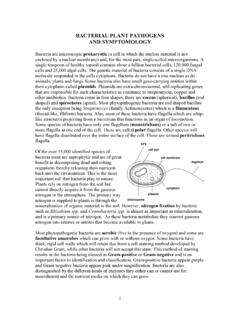Transcription of BACTERIAL CULTURE Notes MEDIA
1 101 BACTERIAL CULTURE MediaMICROBIOLOGYMODULEM icrobiologyNotes9 BACTERIAL INTRODUCTIONWhy bacteria have to be grown (cultured) in the laboratory on artificial culturemedia?1. One of the most important reasons being its utility in diagnosing infectiousdiseases. Isolating an organism from sites in body normally known to besterile is an indication of its role in the disease process. Indeed, isolatingan organism from the clinical specimen is the first step in proving its roleas an etiologic Culturing bacteria is also the initial step in studying its morphology and Bacteria have to be cultured in order to obtain antigens from developingserological assays or Certain genetic studies and manipulations of the cells also need that bacteriabe cultured in Culturing bacteria also provide a reliable way estimating their numbers(viable count).6. Culturing on solid MEDIA is another convenient way of separating bacteriain lesson deals with CULTURE reading this lesson, you will be able to:zenlist the common ingreditents of CULTURE mediumzdescribe about history of CULTURE medium in briefMICROBIOLOGYMODULEB acterial CULTURE MediaMicrobiology 102 Noteszclassify the CULTURE mediazdescribe the preparation and storage of CULTURE mediaWhen culturing bacteria, it is very important to provide similar environmentaland nutritional conditions that exist in its natural habitat.
2 Most CULTURE mediumcontains water, a source of carbon & energy, source of nitrogen, trace elementsand some growth factors. Besides these, optimum pH, oxygen tension andosmolarity too have to be taken into consideration. Some of the ingredients ofculture MEDIA include:While tap water is suitable for CULTURE MEDIA , it must not be used if it containshigh amount of minerals. In such situations, distilled or demineralised watershould be used. Peptone is a byproduct of protein digestion. Proteins are oftenobtained from heart muscle, casein, fibrin or soya flour and is digested usingproteolytic enzymes such as pepsin, trypsin or papain. The final product containspeptones, proteoses and amino acids besides a variety of inorganic saltsincluding phosphates, potassium and magnesium. Casein hydrolysate isobtained from hydrolysis of milk protein casein using HCl or trypsin. Meatextract is obtained by hot water extraction of lean beef and then concentrated byevaporation.
3 Yeast extract is prepared from washed cells of bakers yeast andcontains wide range of amino acids, growth factors and inorganic BRIEF HISTORYR obert Koch realized the importance of solid MEDIA and used potato pieces togrow bacteria and agar was used to solidify CULTURE MEDIA . Before the use of agar,attempts were made to use gelatin as solidifying agent. Gelatin had someinherent problems; it existed as liquid at normal incubating temperatures (35 37oC) and was digested by certain CULTURE MEDIA can be classified in at least three ways; Based onconsistency, based on nutritional component and based on its functional Classification based on consistencyzliquid mediazsemi-solid mediazsolid mediaLiquid mediaIn liquid medium, bacteria grow producing turbidity/ surface pellicle (Vibrio &Bacillus)/ granular deposits (Streptococci). Culturing bacteria in liquid MEDIA 103 BACTERIAL CULTURE MediaMICROBIOLOGYMODULEM icrobiologyNoteshas some drawbacks.
4 Properties of bacteria are not visible in liquid MEDIA andpresence of more than one type of bacteria cannot be mediaAny liquid medium can be rendered solid by the addition of certain solidifyingagents. Agar agar (simply called agar) is the most commonly used solidifyingagent. It is an unbranched polysaccharide obtained from the cell membranes ofsome species of red algae such as the genera Gelidium. Agar is composed of twolong-chain polysaccharides (70% agarose and 30% agarapectin). It melts at 95 Cand solidifies at 42oC, doesn t contribute any nutritive property, it is nothydrolysed by most bacteria and is usually free from growth promoting or growthretarding substances. Agar is available as powders. New Zealand agar andJapanese agar are most commonly used at concentration of 2% and 4%respectively to make a solid mediaReducing the amount of agar to renders a medium semi-solid. Suchmedia are fairly soft and are useful in demonstrating BACTERIAL motility (U-tubeand Cragie s tube).
5 Certain transport MEDIA such as Stuart s and Amies MEDIA aresemi-solid in consistency. Hugh & Leifson s oxidation fermentation test mediumas well as mannitol motility medium are also mediaSometimes, a CULTURE system comprises of both liquid and solid medium in thesame bottle. This is known as biphasic medium (Castaneda system for bloodculture). The inoculum is added to the liquid medium and when subcultures areto be made, the bottle is simply tilted to allow the liquid to flow over the solidmedium. This obviates the need for frequent opening of the CULTURE bottle solidifying agentsBesides agar, egg yolk and serum too can be used to solidify CULTURE containing medium such as Loeffler s serum slope and egg containingmedia such as Lowenstein Jensen (LJ) medium and Dorset egg medium aresolidified as well as disinfected by a process of QUESTIONS The by-product of protein digestion is ..2.. is the most commonly used solidifying agentMICROBIOLOGYMODULEB acterial CULTURE MediaMicrobiology 104 Notes3.
6 CULTURE system having both liquid & solid medium in the same containeris called as ..4.. MEDIA are useful in demonstrating BACTERIAL motility2. Classification based on nutritional componentMedia can be classified as simple, complex and synthetic (or defined). Thosebacteria that are able to grow with minimal requirements are said to non-fastidious and those that require extra nutrients are said to be fastidious. Simplemedia such as peptone water, nutrient agar can support most MEDIA such as blood agar have ingredients whose exact componentsare difficult to or defined MEDIA such as Davis & Mingioli medium are speciallyprepared MEDIA for research purposes where the composition of every componentis well Classification based on functional use or applicationBasal MEDIA are basically simple MEDIA that supports most non-fastidiousbacteria. Peptone water, nutrient broth and nutrient agar considered basalmediumEnriched MEDIA are used to grow nutritionally exacting (fastidious) bacteriaAddition of extra nutrients in the form of blood, serum, egg yolk etc, to basalmedium makes them enriched MEDIA .
7 Blood agar, chocolate agar, Loeffler sserum slope etc are few of the enriched agar is prepared by adding 5-10% (by volume) to a basal medium such asnutrient agar or other blood agar bases. Since blood cannot be sterilized, it has tobe collected aseptically from the animal. Animals have to be bled and the bloodis collected in sterile containers with anticoagulant or glass beads. While sheepblood is preferred, blood from rabbit, horse and ox can also be collected. Humanblood must be avoided since it may contain inhibitory substances includingantibiotics. After the blood agar base is autoclaved, blood is added to the mediumat temperature just above the solidifying point of agar. The mixture is thenpoured on to the plates and allowed to solidify. Blood agar is useful indemonstrating hemolytic properties of certain agar is also known as heated blood agar or lysed blood agar. Theprocedure is similar to that of blood agar preparation except that the blood isadded while the molten blood agar base is still hot.
8 This lyses the blood cells andreleases their contents into the medium. This process turns the medium brown,hence the name. This medium is especially useful in growing Hemophilus sp and 105 BACTERIAL CULTURE MediaMICROBIOLOGYMODULEM icrobiologyNotesNeisseria sp. Serum for medium can be obtained from animal blood but must befiltered through membrane or seitz filter before and enrichment MEDIA are designed to inhibit unwanted commensalor contaminating bacteria and help to recover pathogen from a mixture ofbacteria. While selective MEDIA are agar based, enrichment MEDIA are liquid inconsistency. Various approaches to make a medium selective include addition ofantibiotics, dyes, chemicals, alteration of pH or a combination of Martin Agar used to recover N. gonorrhoeae contains Vancomycin,Colistin and Salt Agar and Salt Milk Agar used to contain 10% NaCl. Potassium tellurite medium used to contains potassium tellurite. McConkey s Agar used forEnterobacteriaceae members contains Bile salt that inhibits most gram positivebacteria.
9 Pseudosel Agar (Cetrimide Agar) used to recover cetrimide. Crystal Violet Blood Agar used to recover crystal violet. Lowenstein Jensen Medium used to is made selective by incorporating malachite green. Wilson &Blair s Agar for recovering is rendered selective by the addition of dyeBrilliant green. TCBS Agar and Monsur s Tellurite Taurocholate Gelatin Agarused for isolating V. cholerae from fecal specimens have elevated pH ( ),which inhibits most other MEDIA are liquid MEDIA that also serves to inhibit commensals inthe clinical specimen. Selenite F broth, tetrathionate broth and alkaline peptonewater are used to recover pathogens from fecal mediaDifferential MEDIA or indicator MEDIA distinguish one microorganism type fromanother growing on the same MEDIA . This type of MEDIA uses the biochemicalcharacteristics of a microorganism growing in the presence of specific nutrientsor indicators (such as neutral red, phenol red or methylene blue) added to themedium to visibly indicate the defining characteristics of a a particular substrate (carbohydrate) is incorporated into a medium and amixture of bacteria inoculated on it, only that bacterium that can ferment itproduces acid.
10 This change in pH is detected by using a pH indicatorincorporated in the medium and the bacterium that can ferment the sugar appearsin a different colour. This approach is used in MacConkey s agar, CLED agar,TCBS agar, XLD agar s agar is the most commonly used MEDIA to CULTURE and identifygram negative bacilli (especially enterobacteriaceae members). It contains bilesalts (selective agent), lactose (sugar), peptone and neutral red (pH indicator),MICROBIOLOGYMODULEB acterial CULTURE MediaMicrobiology 106 Notesagar and water. Those bacteria that can ferment lactose produce pink colouredcolonies where non-lactose fermenting colonies produce colourless , Vibrio cholerae produces yellow coloured colonies on sucrosecontaining TCBS of potassium tellurite to metallic telluriumby Corynebacterium diphtheriae results in production of black colouredcolonies on KT agar. Production of H2S by Salmonella typhi results inproduction of black coloured colonies on Wilson & Blair s fecalis produces black coloured colonies on bile esculin agar dueto reduction of esculin to mediaClinical specimens must be transported to the laboratory immediately aftercollection to prevent overgrowth of contaminating organisms or can be achieved by using transport MEDIA .
